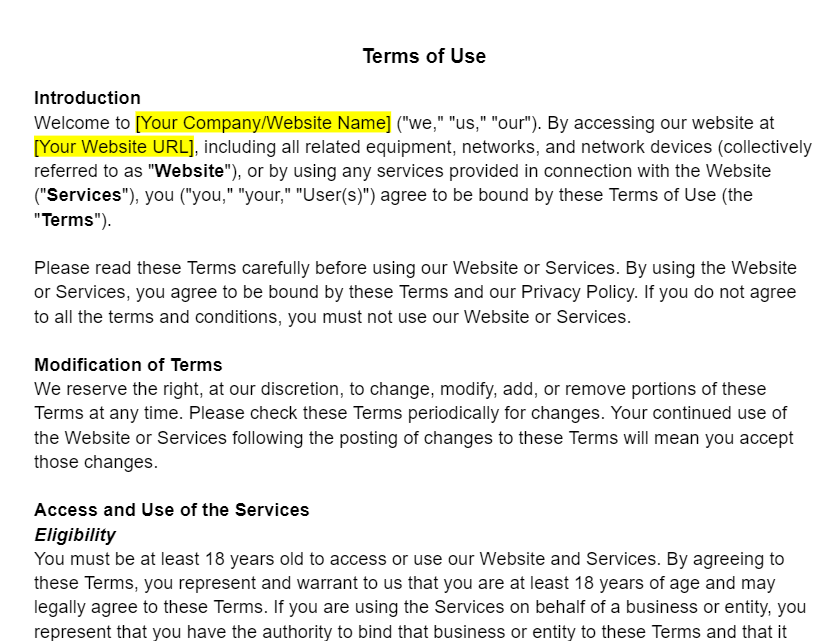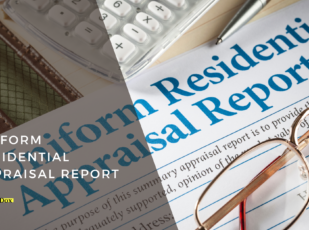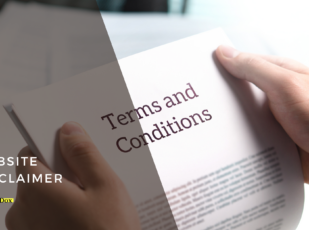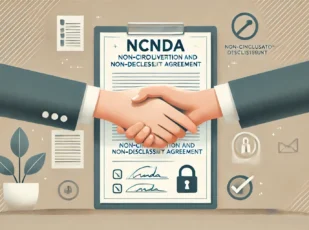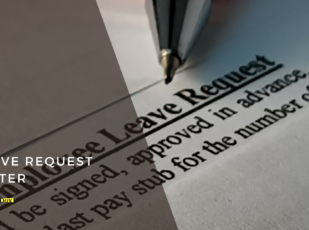
Terms of Use Template
13 Downloads
IP and Copyright
January 2, 2025
Sayantani Dutta
The terms of use agreement for your mobile app or website explains and enforces the rules users must adhere to when accessing and using your digital services or products. In this post, we’ll cover the specifics surrounding this vital agreement and why it’s an absolute legal requirement for your online business and digital strategy.
The Terms of Use Agreement Explained
Don’t confuse an EULA and Terms of Use agreements. The End-User License Agreement (EULA) is an official legal document that covers the terms of use for SaaS platforms or specific software products. The Terms of Use agreement is much broader in the specifics governing the legal use of a website, app, digital product, or service.
There is no technical or legal difference in the Terms of Use, Terms of Service, and Terms and Conditions agreements. All three have the same legal standing and purpose. It covers the specifications, rules, and requirements for the use of a digital service or product and the agreement forms a binding contract between the service provider and the user.
If you operate any of the following online businesses you need this agreement in place to safeguard your company.
- E-commerce sites and apps.
- Physical retail stores.
- Dropshipping businesses.
- Blogs and forums.
- Subscription services.
The Purpose of the Terms of Use Agreement
The Terms of Use agreement gives the business an avenue to pursue disciplinary and legal action against users who take advantage of its product offering or services.
The Terms of Use Prevents Website or App Abuse
The agreement has the particular purpose of limiting unauthorized access to your site and abuse by rogue users. The policy gives you a legal framework to take action against offending users and streamline the response process.
The Terms of Use Limits Your Liabilities
Companies can limit liability in the terms of use policy, protecting your app website from being held accountable and responsible for the following adverse user experiences.
- Loss of income.
- Personal injuries.
- Warranty issues.
- Computer problems.
- Misrepresented services or products.
Establishing your liability framework limits what users of your digital products and services can sue the company for when things go wrong.
The Terms of Use Establishes Your IP Rights
The Terms of Use protect your brand identity and content like logos, images, videos, and page design from copyright infringement under the Digital Millennium Copyright Act (DMCA). Use the Terms of Use to establish any intellectual property rights under copyright laws and explain to users how they cannot reproduce, reuse, distribute, or copy your proprietary materials.
The Terms of Use Minimizes User Disputes
Provisions in the Terms of Use agreement should explain how the company handles conflicts with users and it outlines the resolution process. If users are in contention with the Terms of Use, point to the dispute resolution clause to immediately settle and defuse the issue.
The Terms of Use Builds Trust With Users
A Terms of Use might seem like it’s a one-sided agreement favoring the developer or business. That’s not the case. The Terms of Use actually increase trust with your users by setting their expectations for using your product or service. People expect to see a Terms of Use on your site and if you don’t have one your users might decide to visit the competition if they have legal policies offering better transparency.
Top Tips for Writing the Terms of Use Agreement
In this section, we cover quick and easy tips for writing and structuring your Terms of Use agreement for your app or website.
Make the Terms of Use Easy to Understand and Read
Too many companies post Terms of Use agreements featuring reams of legalese that leave users confused. The Terms of use should be drafted in plain language that’s easy for the user to read and comprehend. Some companies may summarize specific clauses for users in plain language for this specific purpose.
Never Plagiarize Other Terms of Use Agreements
The Terms of Use agreement is specifically compiled for the needs of a website or app, so don’t plagiarize it from other sources online. If you copy another agreement it probably won’t cover all the rules and user requirements you need for your service or product, but you could get in deep trouble as Terms of Use agreements are copyrighted documents.
Common Clauses Found in the Terms of Use Agreement
We just discussed how it’s important to customize the Terms of Use agreement to the business’s specific requirements. While personalizing it to the company’s requirements is critical, there are several common clauses you’ll find in most Terms of Use agreements you find online. Here’s what you need to add to your terms of use policies.
Introduction
This section provides an introductory clause to your terms of use agreement and sets user expectations by defining the agreement and who it covers. It mentions the effective date of the agreement and the parties to it.
Pricing and Payment Terms
Use this section to inform users about the types of currency accepted for your products and services, what payment methods are available, and the process associated with missed payments. If the company sells physical products that ship directly to customers, include links within this clause to other policies outlining these customer services. Here are some examples.
- Shipping policy.
- Return and refund policies.
- No refund policy
- All sales final policy
- Money-back guarantees.
Product Information and Promo Codes
Use this provision to limit liability for product discrepancies experienced by users. State that you have the right to refuse or end promotions or special pricing sales without giving users notice.
Intellectual Property Rights
Your web content, brand identity, and products or services all constitute the company’s Intellectual Property (IP). Mention that all videos, images, branding, and digital content are explicitly owned by the company and set the rules for how users can be legally used, printed, duplicated, and distributed by third parties. Outline what exactly constitutes a violation of these policies and include a copyright disclaimer in this section.
Limitation of Liability
This clause states that the company isn’t responsible for any damages when accessing its services or products. Word this clause as broadly as legally possible.
User Contributions
This clause covers user-generated content (UGC) posted to your website or app. Mention that the company has the sole discretion to use UGC as it sees fit, in a royalty-free manner. This clause can cover UGC on your site, app, or social media accounts.
Prohibited Use and Activities
The prohibited use clause outlines all rules users must follow when accessing and using the company’s products and services. Here is a list of common behaviors and activities defined under prohibited use.
- Crude, obscene, or violent content or posts.
- Misleading or false content.
- Breaking laws.
- Scamming or spamming the service or its users.
- Tampering or hacking the app or website.
- Violation of copyright laws.
- User harassment.
If the company’s app or site provides a lot of user freedom consider adding individual clauses covering prohibited behavior and activities within the Terms of Use agreement.
Termination and Suspension
This clause outlines the company’s right to remove, suspend, or terminate user accounts or profiles. Keep the guidelines as broad as possible.
Dispute Resolution and Governing Laws
The dispute resolution clause explains how the company handles conflict or controversy regarding user violations.
Here are the most common dispute resolutions.
Informal Negotiations: Mention a detailed timeline for negotiations and clearly state the steps in the process.
Arbitration: Mention the mediator handling the dispute, the venue where the arbitration occurs and the party responsible for paying legal fees. State what the arbitration process entails and the governing laws applicable to the arbitration.
Court: Mention the court responsible for handling the case, its location, and applicable governing laws.
Third-Party Links
Add a clause stating the company isn’t responsible for content posted to external sites or webpages linked to the app or site.
Privacy
This clause showcases the company’s commitment to safeguarding personal data in compliance with the California Consumer Privacy Act (CCPA) and the General Data Protection Regulation (GDPR).
Amendments
Outline the process for implementing policy changes in the Terms of Use and how the company will communicate any changes with its users.
Company Contact Information
Include an email address, mailing address, and phone number so users can reach out to the support team with questions or to report policy breaches.
Where To Display Links to the Terms of Use
Make it easy for users to find the company’s Terms of Use agreement by linking it to multiple pages throughout the app or website.
Account Creation Page
Display a link to the agreement on the signup page.
Website Footer
The footer is the primary place to host a link to the policy. The footer shows up on every page on your website making it easy for users to access it anywhere on the site or app.
Privacy Center
The privacy center page hosts the company’s legal privacy compliance documents.
Payment Page
Link the Terms of Use Agreement to the checkout page on your site or app.
Other Locations
Add a link to the company’s Terms of Use in order confirmation emails, shipment tracking pages, and any promotional emails.
User Consent to the Terms of Use Agreement
Get users to agree with the clickwrap or browsewrap consent methods.
Browsewrap (Implied Consent) Method
This method involves the user agreeing to your Terms of Use by landing on your site and using your products or services. Browsewrap consent is typically written into the introduction of the Terms of Use. Companies can also phrase it so that if users don’t agree to the Terms of Use, they may not use its products or services.
Clickwrap (Direct Consent) Method
This method involves the user clicking a check box to show they agree to the Terms of Use agreement. This is direct consent because users are fully aware that by selecting the checkbox they agree to the terms, making it a better option than the implied consent method for legally enforcing the company’s Terms of Use agreement in arbitration or in court.
Seek Legal Assistance
There’s a lot of legal work involved in structuring the protections in the Terms of Use. A contract law attorney assists companies with structuring legal clauses like disclosures, indemnity and severability, and any waiver you need to circumvent user liability. An experienced attorney will ensure there are no inaccuracies in the Terms of Use agreement that might reduce its enforceability in legal disputes.
Why Use a Terms of Use Template for Your Policy?
A Terms and Conditions template takes the hassle out of trying to prep one yourself with no legal assistance. The sample terms of use in the template cover all the provisions and clauses mentioned in this post, all you have to do is customize the specifics of the agreement to your company policies. This approach saves you time and money, giving you a framework to complete the agreement before sending it to your legal advisor for final review.
Download a Customizable Terms of Use Template from FreshDox
Don’t waste your time and energy trying to draft a Terms of Use agreement from scratch using Google Docs or a Terms and Conditions generator. Sign up for a free 7-day trial of the FreshDox platform with a Basic or Premium account.
The Premium account gives you unlimited downloads while the Basic account gives you three free downloads a week. Our fully customized Terms of Use templates for business are generated by legal professionals with years of experience in contract law. Use them for any online business where you need legal protection from rogue users who misuse and abuse your platform, service, or products.
Our Terms of Service template is available for download right now. Sign up for your free trial and get instant access in Word and PDF formats. Minimize liabilities, safeguard the company’s intellectual property, and get the protection you need to handle any legal dispute.
Related Templates
Discover more templates that align with your needs and preferences.

Ready to Sign Up?
Sign up for FreshDox.com’s 7-day trial and discover why so many individuals and businesses trust us for their legal document template needs.
- Cancel any time
- 7-day free trial
- From 300+ Customer Reviews

